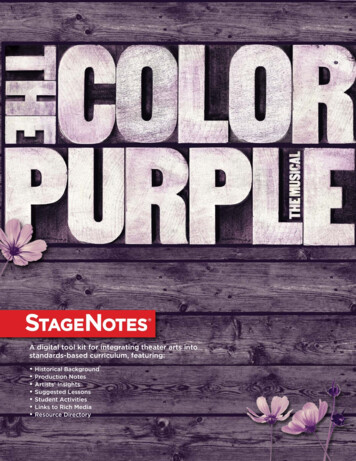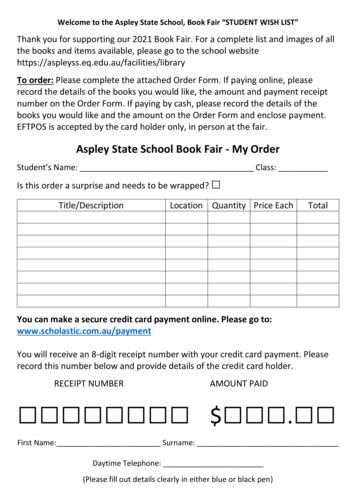
Transcription
A digital tool kit for integrating theater arts intostandards-based curriculum, featuring: Historical Background Production Notes Artists’ Insights Suggested Lessons Student Activities Links to Rich Media Resource Directory
SCOTT SANDERS PRODUCTIONS ROY FURMAN TROIKA ENTERTAINMENT DAVID BABANI TOM SIRACUSACAIOLA PRODUCTIONS JAMES FANTACI TED LIEBOWITZ JAMES L. NEDERLANDER DARREN BAGERTCANDY SPELLING ADAM ZOTOVICH ERIC FALKENSTEIN/MORRIS BERCHARD JUST FOR LAUGHS THEATRICALSTANYA LINK PRODUCTIONS JAM THEATRICALS INDEPENDENT PRESENTERS NETWORK CAROL FINEMANPRESENT THEMUSIC AND LYRICS BYBOOK BYMARSHA NORMAN BRENDA RUSSELL ALLEE WILLIS STEPEHEN BRAYBASED ON THE NOVEL WRITTEN BY ALICE WALKER AND THE WARNER BROS./AMBLIN ENTERTAINMENT MOTION PICTURESET DESIGNCOSTUME DESIGNLIGHTING DESIGNJOHN DOYLE ANN HOULD-WARDSOUND DESIGNASSOCIATE COSTUME DESIGNCASTINGCHRISTOPHER VERGARATELSEY COMPANYJUSTIN HUFF, C.S.A.MUSIC SUPERVISORCATHERINE JAYESMUSIC DIRECTOR/CONDUCTORDARRYL ARCHIBALDTOUR BOOKINGTHE BOOKING GROUPMEREDITH BLAIR & KARA GEBHARTGENERAL MANAGEMENTTROIKA ENTERTAINMENTJIM LANAHANHAIR DESIGNJANE COX DAN MOSES SCHREIER CHARLES G. LAPOINTEORCHESTRATIONSJOSEPH JOUBERTMARKETING & PUBLICITY DIRECTIONMUSIC COORDINATORTALITHA FEHRTOUR SOCIAL MEDIABOND THEATRICAL GROUP MARATHON LIVE ENTERTAINMENTPRODUCTION STAGE MANAGERMELISSA CHACÓNPRODUCTION MANAGEMENTTROIKA ENTERTAINMENTANNA E. BATEASSOCIATE DIRECTORMATT DiCARLODIRECTION AND MUSICAL STAGINGJOHN DOYLETABLE OF CONTENTSThe Page: Alice Walker, The Color Purple, novelist. . . . . . . 4-5The Epistolary Novel . . . . . . . . . . . . . . . . . . . . . . . . . . . . . . . . . 15-16The Stage: John Doyle, The Color Purple, director. . . . . . . . . 6Life Skills: Madame C.J. Walker, Entrepreneur . . . . . . . . . . . . 17The Creative Team . . . . . . . . . . . . . . . . . . . . . . . . . . . . . . . . . . . . . . . 7Performing Arts: The Color Purple composer/lyricists. . 18-19The Color Purple Synopsis . . . . . . . . . . . . . . . . . . . . . . . . . . . . . 8-9Music: The Evolution of the African American Music. . 20-21Musical Numbers. . . . . . . . . . . . . . . . . . . . . . . . . . . . . . . . . . . . . . . . 9Shug Avery’s Sisters: Trailblazing Women in Music. . . . 22-23History: Overview of rural Georgia, 1866-1940 . . . . . . . . . 10-11Timeline of Blues, Jazz and Soul Singers. . . . . . . . . . . . . . . . . 23Social Studies: Missionaries in West Africa . . . . . . . . . . . 12-13Behavior Studies: Gender Roles . . . . . . . . . . . . . . . . . . . . . . . . . 24Language Arts: Marsha Norman, book writer. . . . . . . . . . . 14-15Bibliography & Resources. . . . . . . . . . . . . . . . . . . . . . . . . . . . . . . 25
DEAR EDUCATOR,ga that tellsan inspiring family saThe Color Purple isthrough love,ry of a woman who,the unforgettable stoand discoverumph over adversitytritohgtenstrethfindsal adaptationthe world. This musicher unique voice innovel (and thelitzer Prize–winningof Alice Walker’s Puhts Celie, aSpielberg film) spotligpopular 1985 Stevenl awakeningman whose personawogunyoenddtrodownepic story.forms the arc of thissarye40ofseurcoover thee, gospel, Africanfeaturing jazz, ragtimeorsctsoujoyaithWof hope, a testamenlor Purple is a storyCoeTh,esokblubodaanmusic,ration of life. Withr of love, and a celebssell, Alleeto the healing powelyrics by Brenda Rudansicmudanane Allianceby Marsha Normrple premiered at thPulorCoeTh,ayBrWillis, and Stephened on Broadwayta, Georgia, and openlanAtinyanmpCoTheatre06 Tony Awards,nominated for 11 20swaIt.05201,erl Score. Theon Novembok, and Best OriginaBostBeal,sicMu,including Beston Broadway in 2015d production openedEnteson–WwOffnoisonItndLoof a Musical.ard for Best Revivalwinning the Tony Awof all ages.joyed by audiencesenbetoicaerAmtour acrosscurated for teachersStageNotes has beenofnitioedialecspThistances depicted inry and social circumstohishricthefypliinnovativeto help amr goal is to provide anOule.rpPulorCoethemes andthe story of Thration of the show’sploextheinntsdeway to engage stun lives.be relevant to their owtoenunticoichwhissues—ative team behindce students to the creIn addition, we introdutranslating at into the process ofighinsideovprtoowthe shater production.timeless musical-theaointntioficofrkbeloved woto the castread the novel, listenntsdestuuryortheWhelor Purple willlive on stage, The Coalsicmutheeseorrecording,n.enlighten and entertaiAdriannaHicks (Celie) and thAmericane Northtour castof The Color Purple.Matthew MurphyThe Editor StageNotesFor more information aboutthe National Tour, please visitwww.colorpurple.com.3
THE PAGEMeet Alice Walker, NovelistAlice Walker was born on February 9, 1944, in Eatonton, Georgia, the eighthand youngest child of sharecroppers Willie Lee and Minnie Lou Grant Walker.When Ms. Walker was 8 years old, one of her older brothers accidentallyshot her in the eye with a BB gun. Her father and brother tried to flag downa passing car to take Ms. Walker to the hospital, but the driver, a white man,would not stop. Ms. Walker’s family treated her injury as best they could, butshe ultimately lost her sight in her right eye. When they were able to take her toa doctor, he brusquely dismissed her case as untreatable, offering only a bottleof eyedrops. Her experience with the doctor was an example of the pervasiveracism present in the South at the time.Scar tissue formed over Ms. Walker’sdamaged eye, causing her to be shy andself-conscious. When Ms. Walker was 14,her brother Bill, who had moved north, wasable to raise enough money for her to havean eye operation in Boston. In contrast toher experience in Georgia, the surgeon whoremoved Ms. Walker’s cataract treated her with respect and care.Although she was still self-conscious about her appearance, Ms.Walker was popular in high school. She was valedictorian of her class,and earned a scholarship to Spelman College, a school for black womenin Atlanta, Georgia.Look closely at thepresent you areconstructing. It shouldlook like the future youare dreaming.—Alice WalkerAfter spending two years at Spelman, Ms. Walker transferred to Sarah Lawrence College in New York,and during her junior year traveled to Africa as an exchange student. She received her bachelor of arts degreefrom Sarah Lawrence College in 1966.Ms. Walker’s writing career began to take off: In 1967, her story “To Hell With Dying” was published inThe Best Short Stories by Negro Writers. Her collection of poems, Once, was published in 1968. In 1970, shepublished her first novel, The Third Life of Copeland Grange.She received the Pulitzer Prize in 1983 for The Color Purple, her third novel. She has received many awardsand honors, including the Lillian Smith Award from the National Endowment for the Arts, the RosenthalAward from the National Institute of Arts & Letters, a nomination for the National Book Award, a RadcliffeInstitute Fellowship, a Merrill Fellowship, and a Guggenheim Fellowship.Ms. Walker was active in the civil rights movement of the 1960s, and continues to work as an activist. Shehas spoken for the women’s movement, the antiapartheid movement, the antinuclear movement, and againstfemale genital mutilation. She currently resides in Northern California.To learn more about Alice Walker and her life as an author, visit der-of-life-119885475134
A Conversation With Alice Walker, Authorof The Color Purple, the NovelSTAGENOTES: What were your experiences in high school?ALICE WALKER: I have really good memories of my highschool experience. I was voted “Most Popular” in my senior year,I was prom queen, and I was valedictorian. So I had a reallywonderful time. And why I was writing very sad and miserablepoetry at the same time, I don’t know. High school was good. Itwas a time when I connected very well with other students andteachers. I especially liked typing and learning to sew. I actuallymade my own prom dress out of chartreuse taffeta.STAGENOTES: How do you manage being both a teacher anda writer?ALICE WALKER: I have taught at many schools:Tupelo in Mississippi, Jackson State, Yale, the Universityof California at Berkeley, Wellesley, the University ofMassachusetts. I enjoy it very much. But what happensto me as a writer when I’m teaching is that I get veryinvolved with students. And when I’m involved withthem, it’s very difficult to have the quality time that Ineed to write, so I haven’t taught in a while. But when Igo out on the road, that’s when I teach.Part of having a creative life is understanding asearly as possible how difficult it is to have all theresponsibilities that you can have in life, and be a creativeperson. So part of what I do in my teaching is to say thatto people. I have friends who married in high school, inthe 11th grade. They started having children at 19 and18. If you do that so early, it’s not likely that you’re goingto be able to do what you discover later on that you’d like to do.So really think, think about it. When you’re 16, when you’re 17,when you’re 18. Don’t be in such a rush to get married. By thetime you’re 25, if you’re already married, you will have many asecond thought, I promise you. Don’t be in such a rush to havechildren. Actually, the planet has more children than we’re ableto properly serve, so really consider that.encouraging them to have faith in the characters themselves,that they all have a reason for their behavior. For instance,Mister didn’t just bloom as a mean person for no reason. He hasa history. He has a long past — his father, his grandfather, theplantation system. Enslavement. Reenacting the behavior thathe sees around him, that his father saw around him, and thenthat their father, who was the plantation owner, who was theperson that they were imitating. One of the things I like aboutThe Color Purple is that it’s like a mirror that reflects the wholeperiod of enslavement for black people. So you get to see whatpeople learned about behavior, and you get to say, “Don’t keepdoing this. This is why you were so sad and so depressed and somiserable, because you’re continuing to enslave yourself.”“ I wanted to be a scientist, and thenI wanted to be a pianist, and then Iwanted to be a painter, and all of thosethings were very expensive, and wedidn’t have any money. I became awriter, in a way, because, you know,I’m an artist at heart, and I had to dosomething.”—Alice WalkerSTAGENOTES: What did you think when you first heard themusic by the composers of the show?ALICE WALKER: Well, at first I was not enthusiastic. I didn’treally have any problem thinking of it as a play. I always thoughtit would be a play with a lot of music; there’s music all throughit. It’s all in there — if you have a juke joint, you have music.ALICE WALKER: Scott Sanders, the producer, had earlier sent memusic by some very well known people, extremely famous people.I, of course, didn’t know them. And I was very open to trying tohear them. But in the music that he sent, I couldn’t hear the heartand soul that they really have got to have to do this play. And thenhe finally sent this recording, and he said, “You know, I have thesefriends, and I really like this. See what you think.” He said they werejust tapping out some things with spoons around Allee [Willis]’skitchen table. And I put it in [the player], and I knew right away thatthey had it. They had heart. So I was excited. Finally!STAGENOTES: Did you have advice for the writers who wereadapting The Color Purple into a musical?STAGENOTES: It’s been 30 years since The Color Purple waspublished. Does it seem that long?ALICE WALKER: We have a feeling of mutual respect. I knewthey were about to embark on something huge, and it wouldtake them to some crevices and corners of the human psyche thatmaybe they were not thinking of going to. And I wanted to offerwhat support I could. So, when we met, I remember it as a timeof us sitting around, and many questions arising. I rememberALICE WALKER: No, because time is always current, in someways — there are people who are just discovering the novel today.And they write to me with the same fervor as someone else wrote 30years ago. So the story is alive in that way and, even though I myselfhave written many books since then and rarely think about it in thesame way that a fresh reader is thinking, it has its presence.STAGENOTES: What did you think of the idea of The ColorPurple as a musical?5
THE STAGEMeet John Doyle, Directorof The Color PurplePublished December 8, 2015MINIMALISM BRINGS DOWN BARRIERS IN ‘THE COLOR PURPLE’by Pia CattonIn the current revival of “The Color Purple,” rural Georgiameets spare minimalism.The action takes place on a plain wooden stage. Props arefew: a cluster of well-worn chairs, woven baskets, somefabric, a Bible.Even less would be effective, said director John Doyle, whodesigned the set himself, as long the audience is willing topitch in and activate their imagination.“We have Easter dinner at a table that doesn’t exist,” he said.“We put a circle of chairs together, and it makes a prison. Butit only makes a prison if the audience is prepared to invest inthe image.”Minimalism might seem an odd pairing with Alice Walker’svivid, heartbreaking 1982 novel about racism, abuse andredemption in the American south. And this revival is a majorcontrast to the 2005 original Broadway production, which haddetailed costumes and makeup that aged the characters over ahalf century.interactions onstage, just as a reader would absorb Ms. Walker’svoice via the printed page, he said.And if that requires viewers to do more than show up, that’s theplan.But Mr. Doyle, a seasoned director with four prior Broadwayshows to his credit , wanted to eliminate any barriers betweenthe audience and the emotional lives of the characters.“I not only like it, I insist upon it,” he said gently. “If theateris going to continue to survive and grow, it has to do stuff thatother art forms can’t do.”Even deeper was an urge to plug the audience into theProducer Scott Sanders agrees: “In many cases, we spoon-feedaudiences so much.”Mr. Doyle has developed a reputation for the style andsees more of a connection between his most recent Broadwayproduction, “The Visit” (2015), which was set in a rundowntown, and “The Color Purple,” with its jagged, crumblingbackdrop.Matthew Murphy“They both happen in broken worlds. I think we live in a brokenworld,” he said. “So that’s probably my way of asking the worldto look at itself.”To learn more about John Doyle, visit broadwayworld.com/people/John-Doyle/.Adrianna Hicks (Celie, left) and N’Jameh Camara (Nettie)and the North American tour cast of The Color Purple.6Catton, Pia. “Minimalism Brings Down Barriers in ‘The Color Purple.’” WallStreet Journal, December 8, 2015.
Who’s Who on the Creative TeamALICE WALKER (Original Author) won thePulitzer Prize and the National Book Awardfor her third novel, The Color Purple, whichwas made into an internationally popular filmby Steven Spielberg. Her other best-sellingnovels, which have been translated into morethan two dozen languages, include By the Light of My Father’sSmile, Possessing the Secret of Joy, and The Temple of My Familiar.Her most recent novel, Now Is the Time to Open Your Heart,was published in 2004. Ms. Walker is also the author ofseveral collections of short stories, essays and poems as wellas children’s books. Her work has appeared in numerousnational and international journals and magazines. An activistand social visionary, Ms. Walker’s advocacy on behalf of thedispossessed has, in the words of her biographer, Evelyn C.White, “spanned the globe.”MARSHA NORMAN (Book Writer) won aPulitzer for her play ’night, Mother, a Tony forThe Secret Garden on Broadway, and a Tonynomination for her book for The Color Purple.Ms. Norman is cochair of Playwriting atJuilliard and serves on the Steering Committeeof the Dramatists Guild. She has numerous film and TVcredits, as well as a Peabody for her work in TV. She has wonnumerous awards including the Inge Lifetime Achievementin Playwriting. She is also President of the Lilly AwardsFoundation, a non-profit honoring women in theatre andworking for gender parity nationwide.BRENDA RUSSELL (Composer/Lyricist).Brooklyn-born singer/songwriter and author of“Piano in the Dark,” “If Only for One Night”and “Get Here.” Brenda has collaborated withsuperstars such as Sting; Mary J. Blige; StevieWonder; Chaka Khan; Tina Turner; DonnaSummer; Michael McDonald; Ray Charles; Earth, Wind &Fire; Luther Vandross; Diana Ross; and Patti LaBelle, amongmany others. She was nominated for three Grammys for 1988’s“Piano in the Dark.” Since 1979 she has recorded eight soloalbums, releasing Between the Sun and the Moon in 2004. Herwork has also been featured in How Stella Got Her GrooveBack and Liberty Heights. www.brendarussell.comALLEE WILLIS (Composer/Lyricist) has soldmore than 50 million records, including“September,” “Boogie Wonderland,” “NeutronDance” and “What Have I Done to DeserveThis?” She has a Grammy for the Beverly HillsCop soundtrack and an Emmy nominationfor the “Friends” theme song. She’s an award-winningartist, performer, multimediaist, writer and director. Willisprototyped a social network in 1992 and addressed Congresson cyberspace in 1997. She’s currently working on a massiveproject for Detroit, including a song performed by 7,000people and the feature documentary, Allee Willis LovesDetroit. She is also on the hit TV series, “Storage Wars.”www.alleewillis.comSTEPHEN BRAY (Composer/Lyricist) made hisBroadway debut with The Color Purple in 2005.After training at Berklee College of Music, Braywrote and produced many top-ten recordingsfor Madonna including “Into the Groove,”“Papa Don’t Preach,” “True Blue” and “ExpressYourself.” Performing with Breakfast Club, he earned aGrammy nomination for Best New Artist. He has written andproduced for multiplatinum artists including Gladys Knightand Kylie Minogue. Stephen’s latest venture, Masterphonic,provides storytellers with original music and reimaginedclassics. He would like to thank Mom and Dad for blastingBroadway cast albums and insisting on those piano lessons.JOHN DOYLE (Direction/Set Design/MusicalStaging). Broadway: Sweeney Todd (Tony andDrama Desk Awards for Best Director of aMusical), Company (Tony Award for BestMusical Revival), A Catered Affair (DramaLeague Award for Best Musical Production),The Visit (Tony nomination for Best Musical), The ColorPurple (Tony Award for Best Musical Revival, Drama DeskAward for Best Director of a Musical). Off-Broadway: Wings(Second Stage Theatre), Road Show (The Public Theater),Where’s Charley?, Irma La Douce (City Center Encores!).Regional: Kiss me, Kate (Stratford Festival), The CaucasianChalk Circle (A.C.T.), Merrily We Roll Along, The ThreeSisters (Cincinnati Playhouse in the Park), Ten Cents a Dance(Williamstown Theatre Festival), The Exorcist (L.A.). Inthe U.K., John has been artistic director of four regionaltheatres. Numerous credits include The Gondoliers, Mack andMabel (West End), A Midsummer Night’s Dream (Regent’sPark), Oklahoma! (Chichester), Amadeus (Wilton’s MusicalHall). Opera includes Lucia di Lammermoor (Sydney OperaHouse), Peter Grimes (Metropolitan Opera), The Rise andFall of the City of Mahogany (L.A. Opera). John is ArtisticDirector of CSC in New York City, where productionsinclude Passion, Allegro, Peer Gynt, Dead Poets Society, PacificOvertures and As You Like It.7
SYNOPSISThe Color PurpleAct IMatthew MurphyOn a Sunday morning in 1909, 14-yearold Celie — who has had one child by herfather, Alphonso, and is now pregnant withher second — plays a clapping game withher younger sister Nettie. While attendingservices with the other members of theirrural Georgia community, Celie goes intolabor and is dragged out of the church as thecongregation quietly looks on (“HuckleberryPie”/“Mysterious Ways”). After Celie givesbirth to a son, her father takes the child awayand bluntly tells her he is going to get rid ofit like he did the last one. Celie quietly saysgoodbye to her newborn and asks God for asign (“Somebody Gonna Love You”).Four years later, local farmer and widowerAlbert “Mister” Johnson approaches Alphonsoand asks permission to marry one of hisAdrianna Hicks (Celie, left) and N’Jameh Camara (Nettie) and the Northdaughters. Alphonso agrees, offering himAmerican tour cast of The Color Purple.Celie instead of Nettie, and throws a cow into thebargain. Although the girls promise never to beand encourages her to find her inner strength (“Too Beautiful forseparated, Celie goes with Mister to save Nettie’sWords”).dreams of becoming a teacher (“Our Prayer”). The local churchThat night, at Harpo’s Juke Joint, Shug brings down the houseladies cluck their approval while Mister’s field hands introduce Celiewitha raucous blues number (“Push Da Button”). Sofia arrivesto a life of hard work (“Big Dog”).withher new boyfriend Buster and dances with Harpo, promptingOne day, Nettie arrives, explaining that she is tired ofSqueakto pick a fight with her (“Uh Oh!”). The fight eventuallyAlphonso’s lecherous attentions and asking if she can stay. Misterescalatesinto a bar brawl, prompting Shug and Celie to escape.agrees, but later attacks Nettie while she is walking to school. SheAfterreturningto Mister’s house, Shug and Celie explore theirfights back, prompting Mister to kick her out. Celie protests, butnewfoundrelationship(“What About Love?”). Shug uncovers severalMister swears they will never see each other again. As she leaveslettersforCeliethathavecome from Africa. Celie recognizes Nettie’sMister’s property, Nettie promises to write to Celie. But whenhandwritingandrealizesthather sister is alive.Celie goes to the mailbox the next day, Mister slams the mailboxshut, threatening to kill her if he ever sees her touch it.Act IIIn 1920, Mister’s son Harpo brings home Sofia, a strong-willedWhile reading the letters that Mister has hidden from her, Celiewoman whom he later marries. When Harpo complains that helearns that Nettie is in Africa and is living with the missionaryis tired of Sofia bossing him around, Mister and Celie tell himfamily that adopted her children (“African Homeland”). Inthe only way to get her to listen is to beat her. Harpo attempts toGeorgia, Sofia is arrested for assaulting the mayor after refusingdo so but ends up being beaten by Sofia. After confronting Celie,to work for his wife. When Celie goes to visit her, she learns SofiaSofia learns the extent of Mister’s cruelty and tells Celie to standwill serve out her sentence in the mayor’s custody.up for herself before leaving home to spend time with her sistersIn 1932, Shug brings her lover Grady over for Easter. After(“Hell No!”).learningthe extent of Celie’s anger toward God, Shug invites herHarpo decides to turn his house into a juke joint and engagestocomebackto Memphis with her so they can enjoy the simplein an affair with a waitress named Squeak, who moves in with himjoysoflife(“TheColor Purple”). After sitting down to dinner,(“Brown Betty”). Sometime later, the community prepares forCelietellsMisterthat she is leaving and Squeak announces she isthe arrival of jazz singer Shug Avery, who is revealed to be Mister’sleavingaswell.longtime lover (“Shug Avery Comin’ to Town”). But when ShugWhen Mister refuses and tries to beat her, Celie stands firm andarrives with her band, she is in such bad shape that Celie nurses hercurseshim. Harpo then invites Sofia to come back and live at theback to health in spite of local disapproval.JukeJoint,reconciling with her in the process. Eventually, MisterWhile tailoring a dress for Shug’s debut, Celie experiencesbeginstofeelthe effect of Celie’s curse. Harpo challenges hisfeelings of warmth and tenderness for the first time. Shug,fathertomakethings right after a bunch of terrible things happenmeanwhile, learns more about Celie’s relationship with Misterto Mister, which force Mister to try to understand the meaning8
ACT ONE“Huckleberry Pie”. . . . . . . . . . . . . . . . . . . . . . . . . . Celie and Nettie“Mysterious Ways”. . . . . . . . . . . . . . . . . . . . . . . . . . The Company“Somebody Gonna Love You”. . . . . . . . . . . . . . . . . . . . . . . . Celie“Our Prayer”. . . . . . . . . . . . . . . . . . . . . . . . . . Nettie, Celie, Mister“Big Dog”. . . . . . . . . . . . . . . . . . . . . . . . . . . . . . . . Mister and Men“Hell No!”. . . . . . . . . . . . . . . . . . . . . . . . . . . . . . Sofia and Women“Brown Betty”. . . . . . . . . . . . . . . . . . . . . . Harpo, Squeak, and Men“Shug Avery Comin’ to Town”. . . . . . Mister, Celie, and Company“Too Beautiful for Words”. . . . . . . . . . . . . . . . . . . . . . . . . . . . Shug“Push da Button”. . . . . . . . . . . . . . . . . . . . . . . . Shug and Company“Uh Oh!”. . . . . . . . . . . . . . . . . . . . . . . . . . . . . . . . . . The Company“What About Love?”. . . . . . . . . . . . . . . . . . . . . . . . Celie and ShugACT TWO“African Homeland”. . . . . . . . . . . . . . Nettie, Celie, and Company“The Color Purple”. . . . . . . . . . . . . . . . . . . . . . . . . . . . . . . . . . Shug“Celie’s Curse”. . . . . . . . . . . . . . . . . . . . . . . . . . . . . . . . . . . Mister“Miss Celie’s Pants”. . . . . . . . . . . . . . . . . . . . . . Celie and Women“Any Little Thing” . . . . . . . . . . . . . . . . . . . . . . . . Harpo and Sofia“I’m Here” . . . . . . . . . . . . . . . . . . . . . . . . . . . . . . . . . . . . . . . Celie“The Color Purple” (Reprise). . . . . . . . . . . . . . Celie and CompanyMatthew Murphyof Celie’s curse and the meaning of life other than his toughchildhood (“Celie’s Curse”).At Shug’s Memphis home, Celie starts writing back to Nettieand discovers that she has a natural gift for making pants. Afterinheriting her childhood home, Celie starts a business and beginsselling her designs (“Miss Celie’s Pants”). Meanwhile, Harpo andSofia learn that Mister is having difficulty getting Nettie and thechildren to come to the United States. The three resolve to make aplan (“Any Little Thing”).Shug tells Celie that she has fallen in love with a 19-year-oldmusician in her band and asks her permission to have one last flingwith him. Meanwhile, Mister has reconciled his life. While walkinghome, Celie realizes that she isn’t destroyed by this and, for the firsttime, feels a deep love for herself (“I’m Here”).Several years later, while hosting a Fourth of July picnic for thecommunity, Celie hears a car horn and a familiar voice from herchildhood. It is Nettie singing the clapping song they sang yearsbefore. They both run to each other and hug with Celie’s childrenright behind them all grown-up. After learning that Mister andShug have made the reunion possible, Celie thanks them and Godfor reuniting her with her sister (“The Color Purple (Reprise)”).Musical NumbersCarla R. Stewart (Shug, left) and Adrianna Hicks (Celie) and the North American tour cast of The Color Purple.9
HISTORYCELIE’S HOMEA brief overview of African American lifein rural GeorgiaThe Color Purple takes place in a ruralGeorgia community near the town ofEatonton, where Alice Walker, theauthor of the novel, was born.In 1865, at the end of the CivilWar, Congress passed the 13thAmendment to the United StatesConstitution, which prohibitedslavery, freeing the slaves throughoutthe South. This was known asEmancipation.In Georgia, there were more than400,000 slaves. It took until the end of1865 for Northern troops to spread the newsof Emancipation to every corner of the state. SomeGeorgia freedmen (the term for the newly emancipatedslaves) immediately went to the major cities, Atlanta andSavannah, looking for a new way of life. Others traveledthroughout the South, seeking to reunite with family membersfrom whom they had been separated. Others opened schoolsor established churches. And some took their freedom in smallsteps, finding out what it was like to be able to take a few hoursoff from work during the day, or to enjoy a stroll wearing one’sbest clothes in the town streets.As former slaves adjusted to freedom, Georgia society wasin chaos. Northern officials assumed that whites and blackswould transition easily from the master-slave relationship toan employer-employee relationship. This was not the case;plantation owners wanted blacks to stay in their same powerlesspositions, accepting the same conditions that theylived under during slavery. The freedmen, however,refused to work the same long hours for little orno pay. Tensions were high as each side tried tobecome used to a new relationship with the other.As part of Reconstruction, the political andsocietal reorganization of the South after the war,freedmen were promised land. In Georgia, formerslaves were granted 40-acre parcels, mostly nearthe coast. Only about 80,000 acres of land weredistributed in this way, and some of it was takenaway after crops were harvested. Only those newlandowners who had court decrees supporting theirclaims were able to keep their land.For those who did not have property of theirown, the white landowners created a system thatwas a new form of slavery: sharecropping. Black10farmers (and some poor whites) would begranted the right to lease a portion ofwhite-owned farmland, working theland in exchange for a share of
Alice Walker was born on February 9, 1944, in Eatonton, Georgia, the eighth and youngest child of sharecroppers Willie Lee and Minnie Lou Grant Walker. When Ms. Walker was 8 years old, one of her older brothers accidentally shot her in the eye











